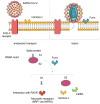Association between COVID-19 Diagnosis and Coronary Artery Thrombosis: A Narrative Review
- PMID: 35327504
- PMCID: PMC8945192
- DOI: 10.3390/biomedicines10030702
Association between COVID-19 Diagnosis and Coronary Artery Thrombosis: A Narrative Review
Abstract
Coronavirus disease 2019 is characterized by its severe respiratory effects. Data early on indicated an increased risk of mortality in patients with cardiovascular comorbidities. Early reports highlighted the multisystem inflammatory syndrome, cytokine storm, and thromboembolic events as part of the disease processes. The aim of this review is to assess the association between COVID-19 and its thrombotic complications, specifically related to the cardiovascular system. The role of neutrophil extracellular traps (NETs) is explored in the pathogenesis of the disease. The structure and anatomy of the virus are pivotal to its virulence in comparison to other α and β Coronaviridae (HCoV-229E, HCoV-OC43, HCoV-229E, HCoV-NL63, HCoV-OC43, and HCoV-HKU1). In particular, the host interaction and response may explain the variability of severity in patients. Angio tensin-converting enzyme 2 (ACE2) activation may be implicated in the cardiovascular and throm bogenic potential of the disease. The virus may also have direct effects on the endothelial lining affecting hemostasis and resulting in thrombosis through several mechanisms. Dipyridamole may have a therapeutic benefit in NET suppression. Therapeutic avenues should be concentrated on the different pathophysiological steps involving the virus and the host.
Keywords: COVID-19; SARS-CoV-2 infection; coronary artery thrombosis; neutrophil extracellular traps (NETs).
Conflict of interest statement
The authors declare no conflict of interest.
Figures






References
-
- Driggin E., Madhavan M.V., Bikdeli B., Chuich T., Laracy J., Biondi-Zoccai G., Brown T.S., Der Nigoghossian C., Zidar D.A., Haythe J., et al. Cardiovascular considerations for patients, health care workers, and health systems during the coronavirus disease 2019 (COVID-19) pandemic. J. Am. Coll. Cardiol. 2020;75:2352–2371. doi: 10.1016/j.jacc.2020.03.031. - DOI - PMC - PubMed
-
- Saad M., Kennedy K.F., Imran H., Louis D.W., Shippey E., Poppas A., Wood K.E., Abbott J.D., Aronow H.D. Association Between COVID-19 Diagnosis and In-Hospital Mortality in Patients Hospitalized with ST-Segment Elevation Myocardial Infarction. JAMA. 2021;326:1940–1952. doi: 10.1001/jama.2021.18890. - DOI - PMC - PubMed
Publication types
LinkOut - more resources
Full Text Sources
Miscellaneous

